Abstract
Pretreatment with two biological response modifiers (BRM), OK-432 and PS-K, protected mice from lethal infection by murine cytomegalovirus (MCMV). This was evidenced by an increase in 50% lethal doses and a decrease in titers of infectious viruses replicated in the liver and spleen. Spleen cells from the BRM-treated mice augmented the natural killer (NK) cell activity and suppressed the replication of MCMV in vitro. During MCMV infection, the NK cell activity of the spleen cells was maintained at a high level in the BRM-treated mice, whereas it was severely impaired in untreated mice. The BRM-induced protection was nullified by concomitant administration of antiasialo GM1 antibody. Interferon was neither induced by BRM treatment nor enhanced in BRM-pretreated and MCMV-infected mice. Thus, the protective effect of OK-432 and PS-K seems to be based on activation of NK cells and prevention of MCMV-induced inhibition of the NK cell activity.
Full text
PDF
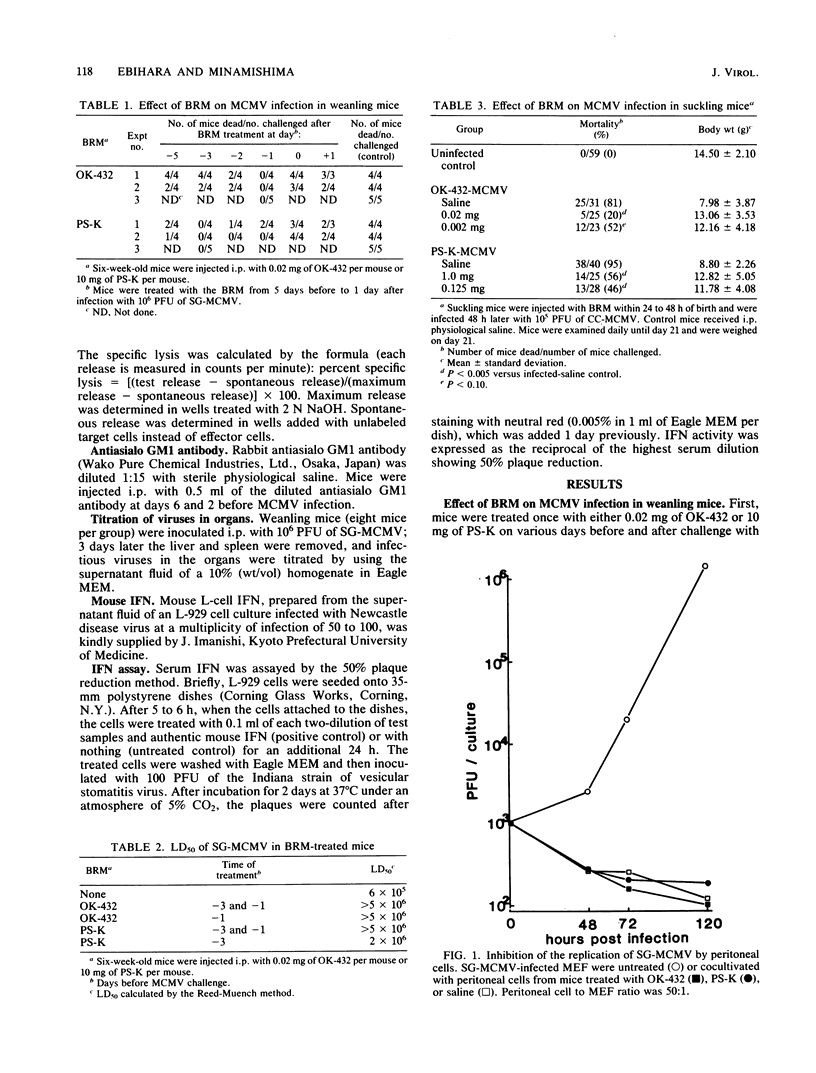
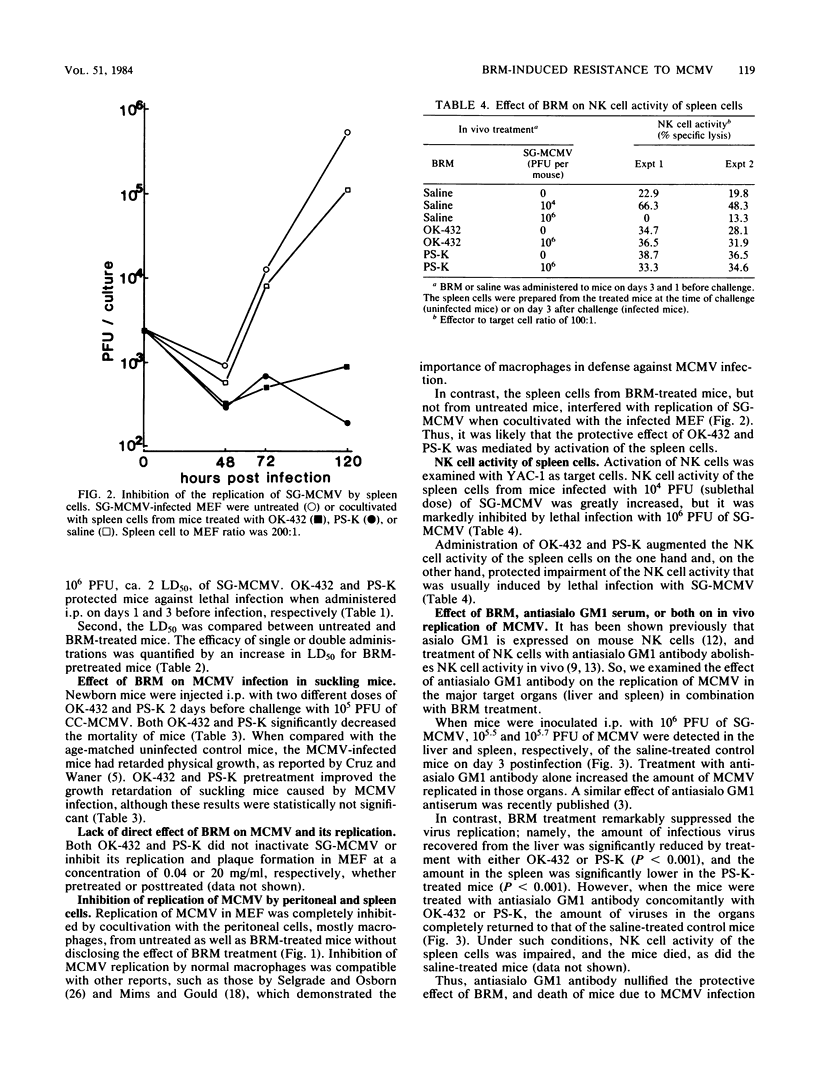
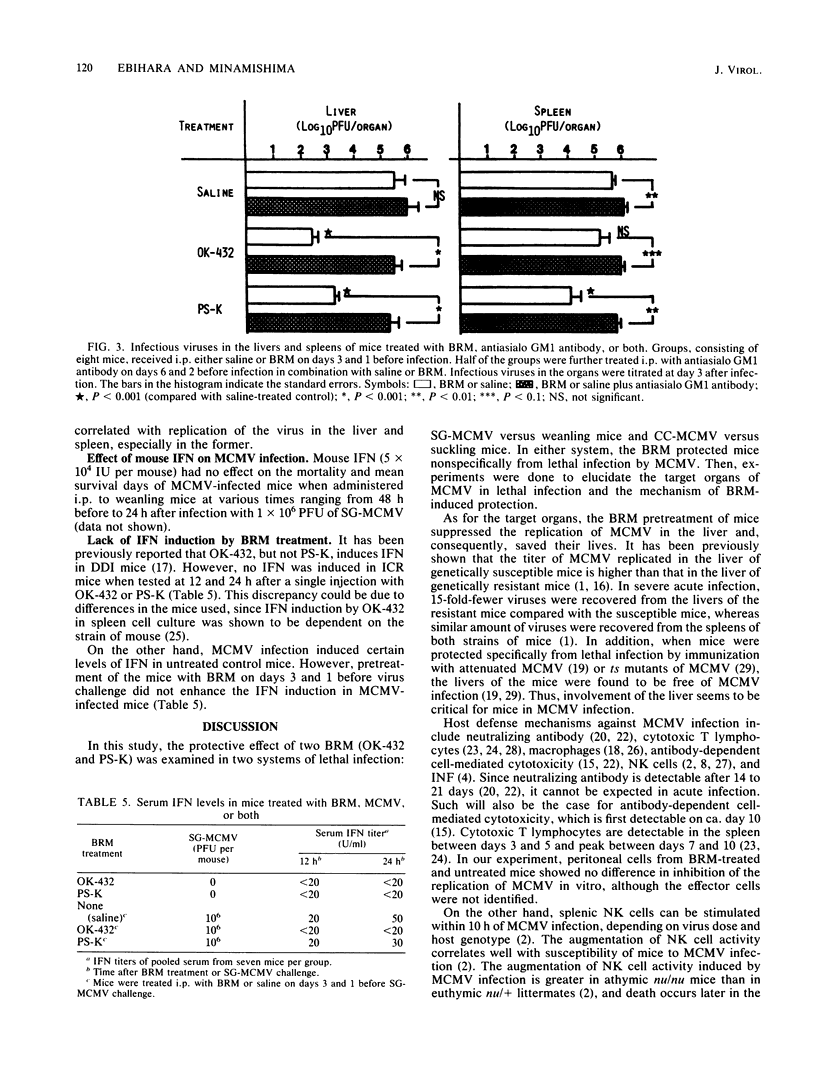
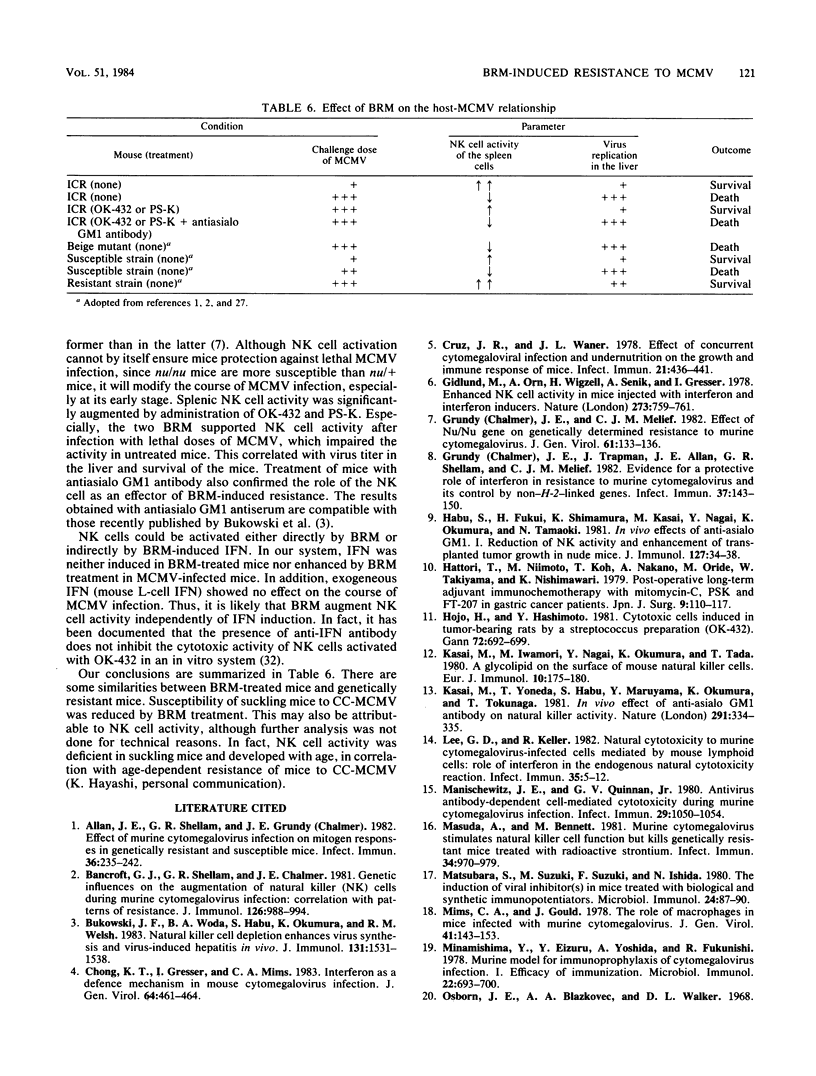
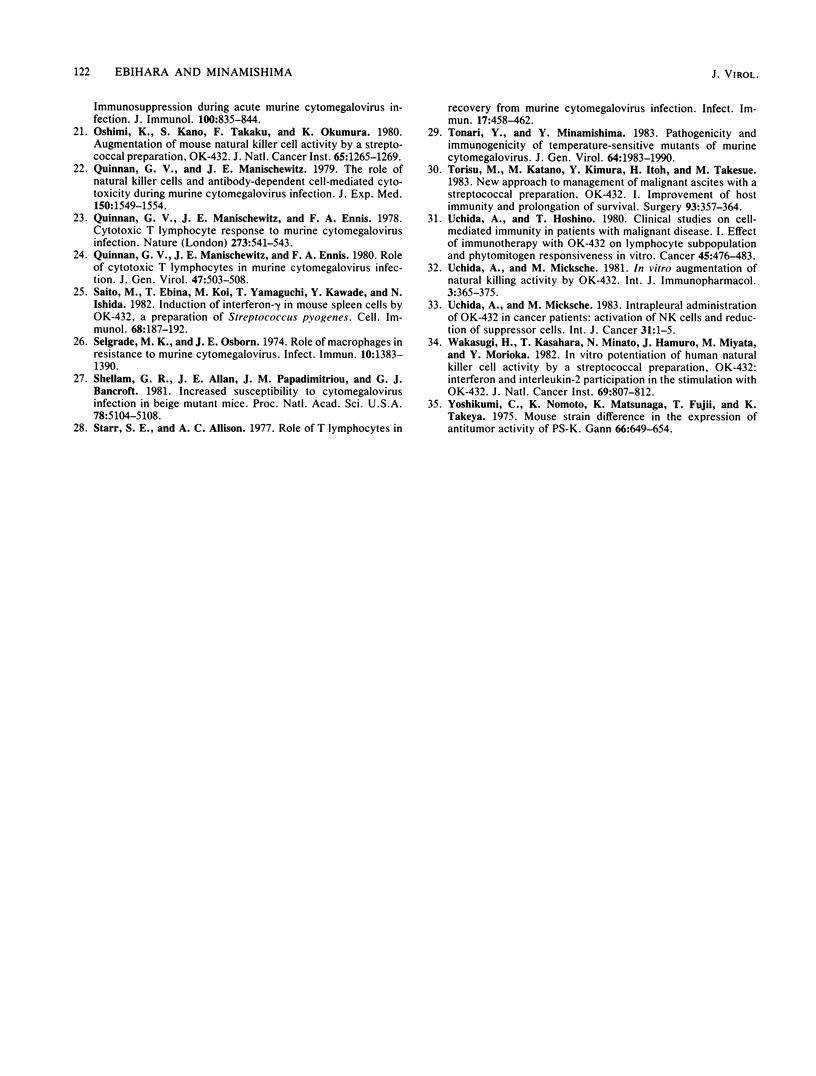
Selected References
These references are in PubMed. This may not be the complete list of references from this article.
- Allan J. E., Shellam G. R., Grundy J. E. Effect of murine cytomegalovirus infection on mitogen responses in genetically resistant and susceptible mice. Infect Immun. 1982 Apr;36(1):235–242. doi: 10.1128/iai.36.1.235-242.1982. [DOI] [PMC free article] [PubMed] [Google Scholar]
- Bancroft G. J., Shellam G. R., Chalmer J. E. Genetic influences on the augmentation of natural killer (NK) cells during murine cytomegalovirus infection: correlation with patterns of resistance. J Immunol. 1981 Mar;126(3):988–994. [PubMed] [Google Scholar]
- Bukowski J. F., Woda B. A., Habu S., Okumura K., Welsh R. M. Natural killer cell depletion enhances virus synthesis and virus-induced hepatitis in vivo. J Immunol. 1983 Sep;131(3):1531–1538. [PubMed] [Google Scholar]
- Chong K. T., Gresser I., Mims C. A. Interferon as a defence mechanism in mouse cytomegalovirus infection. J Gen Virol. 1983 Feb;64(Pt 2):461–464. doi: 10.1099/0022-1317-64-2-461. [DOI] [PubMed] [Google Scholar]
- Cruz J. R., Waner J. L. Effect of concurrent cytomegaloviral infection and undernutrition on the growth and immune response of mice. Infect Immun. 1978 Aug;21(2):436–441. doi: 10.1128/iai.21.2.436-441.1978. [DOI] [PMC free article] [PubMed] [Google Scholar]
- Gidlund M., Orn A., Wigzell H., Senik A., Gresser I. Enhanced NK cell activity in mice injected with interferon and interferon inducers. Nature. 1978 Jun 29;273(5665):759–761. doi: 10.1038/273759a0. [DOI] [PubMed] [Google Scholar]
- Grundy J. E., Melief C. J. Effect of Nu/Nu gene on genetically determined resistance to murine cytomegalovirus. J Gen Virol. 1982 Jul;61(Pt 50):133–136. doi: 10.1099/0022-1317-61-1-133. [DOI] [PubMed] [Google Scholar]
- Grundy J. E., Trapman J., Allan J. E., Shellam G. R., Melief C. J. Evidence for a protective role of interferon in resistance to murine cytomegalovirus and its control by non-H-2-linked genes. Infect Immun. 1982 Jul;37(1):143–150. doi: 10.1128/iai.37.1.143-150.1982. [DOI] [PMC free article] [PubMed] [Google Scholar]
- Habu S., Fukui H., Shimamura K., Kasai M., Nagai Y., Okumura K., Tamaoki N. In vivo effects of anti-asialo GM1. I. Reduction of NK activity and enhancement of transplanted tumor growth in nude mice. J Immunol. 1981 Jul;127(1):34–38. [PubMed] [Google Scholar]
- Hattori T., Niimoto M., Koh T., Nakano A., Oride M., Takiyama W., Nishimawari K. Post-operative long-term adjuvant immunochemotherapy with mitomycin-C, PSK and FT-207 in gastric cancer patients. Jpn J Surg. 1979 Jun;9(2):110–117. doi: 10.1007/BF02468845. [DOI] [PubMed] [Google Scholar]
- Hojo H., Hashimoto Y. Cytotoxic cells induced in tumor-bearing rats by a streptococcus preparation (OK-432). Gan. 1981 Oct;72(5):692–699. [PubMed] [Google Scholar]
- Kasai M., Iwamori M., Nagai Y., Okumura K., Tada T. A glycolipid on the surface of mouse natural killer cells. Eur J Immunol. 1980 Mar;10(3):175–180. doi: 10.1002/eji.1830100304. [DOI] [PubMed] [Google Scholar]
- Kasai M., Yoneda T., Habu S., Maruyama Y., Okumura K., Tokunaga T. In vivo effect of anti-asialo GM1 antibody on natural killer activity. Nature. 1981 May 28;291(5813):334–335. doi: 10.1038/291334a0. [DOI] [PubMed] [Google Scholar]
- Lee G. D., Keller R. Natural cytotoxicity of murine cytomegalovirus-infected cells mediated by mouse lymphoid cells: role of interferon in the endogenous natural cytotoxicity reaction. Infect Immun. 1982 Jan;35(1):5–12. doi: 10.1128/iai.35.1.5-12.1982. [DOI] [PMC free article] [PubMed] [Google Scholar]
- Manischewitz J. E., Quinnan G. V., Jr Antivirus antibody-dependent cell-mediated cytotoxicity during murine cytomegalovirus infection. Infect Immun. 1980 Sep;29(3):1050–1054. doi: 10.1128/iai.29.3.1050-1054.1980. [DOI] [PMC free article] [PubMed] [Google Scholar]
- Masuda A., Bennett M. Murine cytomegalovirus stimulates natural killer cell function but kills genetically resistant mice treated with radioactive strontium. Infect Immun. 1981 Dec;34(3):970–979. doi: 10.1128/iai.34.3.970-979.1981. [DOI] [PMC free article] [PubMed] [Google Scholar]
- Matsubara S., Suzuki M., Suzuki F., Ishida N. The induction of viral inhibitor(s) in mice treated with biological and synthetic immunopotentiators. Microbiol Immunol. 1980;24(1):87–90. doi: 10.1111/j.1348-0421.1980.tb00565.x. [DOI] [PubMed] [Google Scholar]
- Mims C. A., Gould J. The role of macrophages in mice infected with murine cytomegalovirus. J Gen Virol. 1978 Oct;41(1):143–153. doi: 10.1099/0022-1317-41-1-143. [DOI] [PubMed] [Google Scholar]
- Minamishima Y., Eizuru Y., Yoshida A., Fukunishi R. Murine model for immunoprophylaxis of cytomegalovirus infection. I. Efficacy of immunization. Microbiol Immunol. 1978;22(11):693–700. doi: 10.1111/j.1348-0421.1978.tb00422.x. [DOI] [PubMed] [Google Scholar]
- Osborn J. E., Blazkovec A. A., Walker D. L. Immunosuppression during acute murine cytomegalovirus infection. J Immunol. 1968 Apr;100(4):835–844. [PubMed] [Google Scholar]
- Oshimi K., Kano S., Takaku F., Okumura K. Augmentation of mouse natural killer cell activity by a streptococcal preparation, OK-432. J Natl Cancer Inst. 1980 Dec;65(6):1265–1269. [PubMed] [Google Scholar]
- Quinnan G. V., Manischewitz J. E., Ennis F. A. Cytotoxic T lymphocyte response to murine cytomegalovirus infection. Nature. 1978 Jun 15;273(5663):541–543. doi: 10.1038/273541a0. [DOI] [PubMed] [Google Scholar]
- Quinnan G. V., Manischewitz J. E., Ennis P. A. Role of cytotoxic T lymphocytes in murine cytomegalovirus infection. J Gen Virol. 1980 Apr;47(2):503–508. doi: 10.1099/0022-1317-47-2-503. [DOI] [PubMed] [Google Scholar]
- Quinnan G. V., Manischewitz J. E. The role of natural killer cells and antibody-dependent cell-mediated cytotoxicity during murine cytomegalovirus infection. J Exp Med. 1979 Dec 1;150(6):1549–1554. doi: 10.1084/jem.150.6.1549. [DOI] [PMC free article] [PubMed] [Google Scholar]
- Saito M., Ebina T., Koi M., Yamaguchi T., Kawade Y., Ishida N. Induction of interferon-gamma in mouse spleen cells by OK-432, a preparation of Streptococcus pyogenes. Cell Immunol. 1982 Mar 15;68(1):187–192. doi: 10.1016/0008-8749(82)90102-2. [DOI] [PubMed] [Google Scholar]
- Selgrade M. K., Osborn J. E. Role of macrophages in resistance to murine cytomegalovirus. Infect Immun. 1974 Dec;10(6):1383–1390. doi: 10.1128/iai.10.6.1383-1390.1974. [DOI] [PMC free article] [PubMed] [Google Scholar]
- Shellam G. R., Allan J. E., Papadimitriou J. M., Bancroft G. J. Increased susceptibility to cytomegalovirus infection in beige mutant mice. Proc Natl Acad Sci U S A. 1981 Aug;78(8):5104–5108. doi: 10.1073/pnas.78.8.5104. [DOI] [PMC free article] [PubMed] [Google Scholar]
- Starr S. E., Allison A. C. Role of T lymphocytes in recovery from murine cytomegalovirus infection. Infect Immun. 1977 Aug;17(2):458–462. doi: 10.1128/iai.17.2.458-462.1977. [DOI] [PMC free article] [PubMed] [Google Scholar]
- Tonari Y., Minamishima Y. Pathogenicity and immunogenicity of temperature-sensitive mutants of murine cytomegalovirus. J Gen Virol. 1983 Sep;64(Pt 9):1983–1990. doi: 10.1099/0022-1317-64-9-1983. [DOI] [PubMed] [Google Scholar]
- Torisu M., Katano M., Kimura Y., Itoh H., Takesue M. New approach to management of malignant ascites with a streptococcal preparation, OK-432. I. Improvement of host immunity and prolongation of survival. Surgery. 1983 Mar;93(3):357–364. [PubMed] [Google Scholar]
- Uchida A., Hoshino T. Clinical studies on cell-mediated immunity in patients with malignant disease. I. Effect of immunotherapy with OK-432 on lymphocyte subpopulation and phytomitogen responsiveness in vitro. Cancer. 1980 Feb;45(3):476–483. doi: 10.1002/1097-0142(19800201)45:3<476::aid-cncr2820450311>3.0.co;2-7. [DOI] [PubMed] [Google Scholar]
- Uchida A., Micksche M. In vitro augmentation of natural killing activity by OK-432. Int J Immunopharmacol. 1981;3(4):365–375. doi: 10.1016/0192-0561(81)90032-1. [DOI] [PubMed] [Google Scholar]
- Uchida A., Micksche M. Intrapleural administration of OK432 in cancer patients: activation of NK cells and reduction of suppressor cells. Int J Cancer. 1983 Jan 15;31(1):1–5. doi: 10.1002/ijc.2910310102. [DOI] [PubMed] [Google Scholar]
- Wakasugi H., Kasahara T., Minato N., Hamuro J., Miyata M., Morioka Y. In vitro potentiation of human natural killer cell activity by a streptococcal preparation, OK-432: interferon and interleukin-2 participation in the stimulation with OK-432. J Natl Cancer Inst. 1982 Oct;69(4):807–812. [PubMed] [Google Scholar]
- Yoshikumi C., Nomoto K., Matsunaga K., Fuji T., Takeya K. Mouse strain difference in the expression of antitumor activity of PS-K. Gan. 1975 Dec;66(6):649–654. [PubMed] [Google Scholar]


